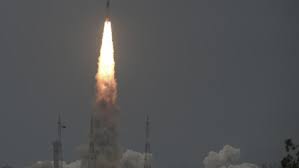
The Indian Space Research Organisation (ISRO) added another feather to its cap with the successful launch of the Polar Satellite Launch Vehicle (PSLV) carrying seven Singaporean satellites. The mission, named PSLV-C56, took off from the Satish Dhawan Space Centre in Sriharikota, Andhra Pradesh, marking a significant step in India’s space endeavors.
After a flawless liftoff, the PSLV rocket embarked on its journey to place the satellites into their designated orbits. Approximately 23 minutes after takeoff, the rocket gracefully released all seven payloads into the near-equatorial orbit (NEO) at an altitude of 535 km, as confirmed by ISRO officials.
The main highlight of the mission was the successful deployment of the DS-SAR satellite, developed in collaboration with the Government of Singapore’s Defence Science and Technology Agency and ST Engineering. This cutting-edge satellite is uniquely designed to cater to the satellite imagery requirements of various governmental agencies within Singapore. The DS-SAR satellite will play a crucial role in supporting vital tasks such as urban planning, disaster management, environmental monitoring, and national security, significantly enhancing Singapore’s capabilities in these domains.
The DS-SAR satellite was placed into a near-equatorial orbit at a 5-degree inclination, making it ideal for capturing images of tropical regions, which are often challenging for satellites in other orbits to cover comprehensively.
In addition to DS-SAR, the PSLV-C56 mission carried six co-passenger customer satellites. Among them were:
- VELOX-AM: A 23 kg technology demonstration microsatellite aimed at testing and validating various technologies in space.
- ARCADE: An experimental satellite tasked with studying atmospheric coupling and dynamics.
- SCOOB-II: A 3U nanosatellite equipped with a technology demonstrator payload.
- NuLIoN by NuSpace: An advanced 3U nanosatellite that will facilitate seamless Internet of Things (IoT) connectivity, benefiting both urban and remote areas.
- Galassia-2: A 3U nanosatellite designed for low earth orbit operations.
- ORB-12 STRIDER: A satellite developed through international collaboration, undertaking undisclosed mission objectives.
The PSLV-C56 mission’s success marked the 58th flight of PSLV and the 17th flight in the core-alone configuration. The Indian Space Research Organisation’s prowess in delivering reliable and efficient launch services to its international partners was once again evident, further strengthening India’s position as a key player in the global space industry.
The successful deployment of the DS-SAR satellite and its co-passengers is a testament to the growing capabilities of ISRO and the collaborative efforts between India and Singapore in advancing space technology and research.
As the DS-SAR satellite becomes operational, it is expected to significantly contribute to Singapore’s technological advancement and bolster its capabilities in various sectors, ultimately benefiting the citizens of both nations and fostering further cooperation in the field of space exploration and satellite technology.
Sources By Agencies




